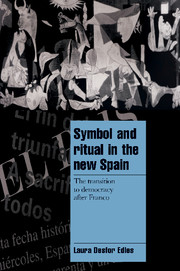Book contents
- Frontmatter
- Contents
- List of tables
- List of figures
- List of abbreviations
- Acknowledgements
- Map of Spain
- Part I Interpreting the Spanish transition to democracy
- Part II The symbolic basis of Spanish consensus
- Part III Conflict and consensus in the institutionalization of Spanish democracy
- 7 Democratic reaggregation and the 1978 Constitution
- 8 The Basque exception: questions of communality and democracy
- 9 Conclusion and epilogue
- Notes
- References
- Index
7 - Democratic reaggregation and the 1978 Constitution
Published online by Cambridge University Press: 06 July 2010
- Frontmatter
- Contents
- List of tables
- List of figures
- List of abbreviations
- Acknowledgements
- Map of Spain
- Part I Interpreting the Spanish transition to democracy
- Part II The symbolic basis of Spanish consensus
- Part III Conflict and consensus in the institutionalization of Spanish democracy
- 7 Democratic reaggregation and the 1978 Constitution
- 8 The Basque exception: questions of communality and democracy
- 9 Conclusion and epilogue
- Notes
- References
- Index
Summary
In the previous chapter we saw that there was a critical symbolic dimension to the drafting of the Moncloa Pacts. The Moncloa pacting reaffirmed a (sacred) “new beginning” of “convivencia”/“national reconciliation,” and “democracy” in symbolic opposition to (profane) “Civil War” (see Figure 6.1); and it ritualized the communal state of liminality in the process of transition (see Table 4.1). We also saw that the drafting of the Moncloa Pacts engendered a specific strategy of elite negotiation, called the “politics of consensus.” This strategy was evoked again in the drafting of the Spanish Constitution. In both cases, party leaders confronted and worked through potentially explosive issues by wittingly and unwittingly calling up the core transitional symbols of “a new beginning” of “democracy” and “national reconciliation.” The drafting of the 1978 Constitution was a far more lengthy, complicated and consequential process than the drafting of the Moncloa Pacts, however.
Constitutionalism and symbolization
In the industrialized nations of the West, constitutionalism represents the claim that the people possess the authority to regulate the relations among all members of the political community, including those who govern. While in the older states, the constitution typically was drafted by a group of revolutionaries united in their opposition to political autocracy, in the new nations of the twentieth century the constitution is not so much a revolutionary document of liberation as an effort by the ruling elite to integrate a diverse, already mobilized, national population.
- Type
- Chapter
- Information
- Symbol and Ritual in the New SpainThe Transition to Democracy after Franco, pp. 101 - 121Publisher: Cambridge University PressPrint publication year: 1998



